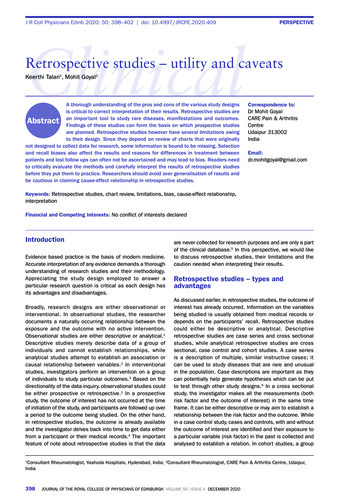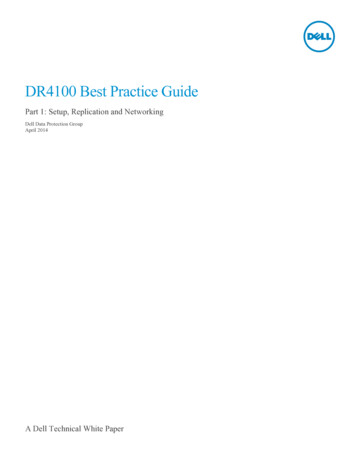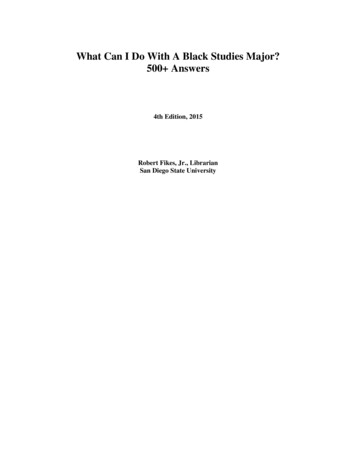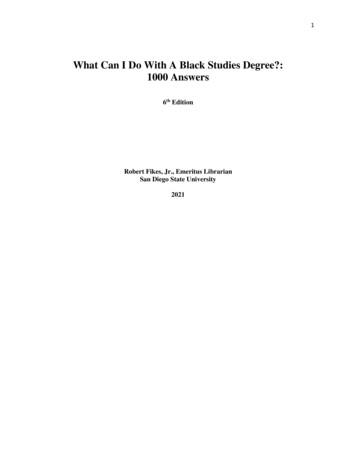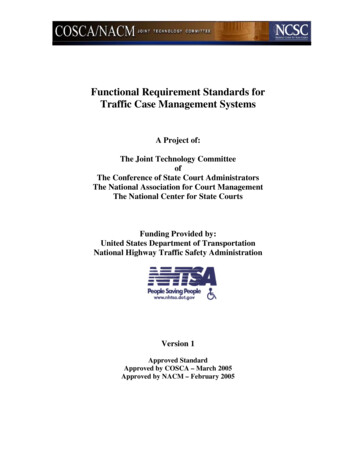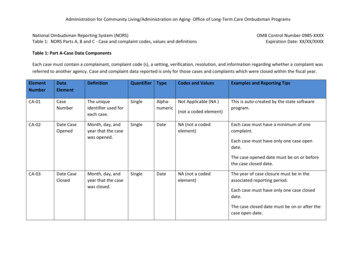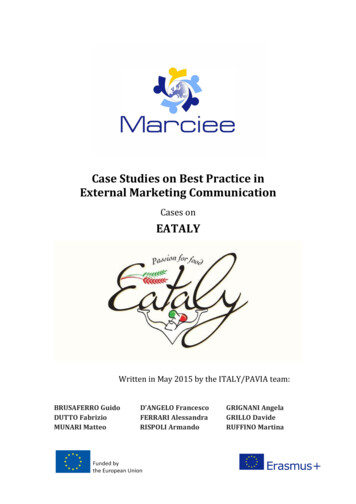
Transcription
Case Studies on Best Practice inExternal Marketing CommunicationCases onEATALYWritten in May 2015 by the ITALY/PAVIA team:BRUSAFERRO GuidoDUTTO FabrizioMUNARI MatteoD’ANGELO FrancescoFERRARI AlessandraRISPOLI ArmandoGRIGNANI AngelaGRILLO DavideRUFFINO Martina
Executive summary:Eataly is an international company founded in 2007Eataly operates in the food sector as a mass distributor but their core business has apeculiarity: in the same place you can buy, eat and learn about high-quality Italianfood. Indeed in their stores there is a big selection of Italian typical products that youcan take and cook at home but there are also a lot of restaurants (some have alsochefs awarded with Michelin stars). Eataly organizes often courses and events, intheir shops, to teach to their customers the characteristics of foods and how to cookit.An entrepreneurial companyThe founder and creator of Eataly is Oscar Farinetti, currently the CEO of thecompany. The strength point of the company is the union of the above citedactivities (shopping, restaurants and cooking lessons) that poses it in a positionwhere there are almost no competitors.An example of best practiceEataly is an example of best practice in marketing communication whereas it has adifferent way of communicate: first of all its brand recognition is a fundamentalelement, then it has some peculiarity such as its poster designing, that are veryoverwhelming to clients’ eyes. Another best practice of Eataly is its ability tocommunicate and dialogue with clients through its social media channels. Indeed itspresent on Facebook, Twitter, Instagram and other social network sites.Main markets and international issuesEtaly operates mainly in Italy, USA, Japan, Emirates Stases and Turkey.In these countries it has different strategies: abroad, instead of regional productscoming from small local producers, you can find well-known Italian brands used toattract foreign customers. The main segments of Eataly is people less sensitive to theprice in favor of the quality of food.
Foundation2007IndustryFoodCore businessFood retailersFounder and CEOOscar FarinettiSales turnover300mln (2013)Main marketsItaly, US, JapanCustomer segmentHigh quality food loversWebsitewww.eataly.netwww.eataly.com
Introduction of EATALYEataly is an international company that has revolutionized the way in which peoplecan buy, consume but, first of all, learn about food. Indeed, the core activity ofEataly is to sell top quality Italian food all around the world, through their web site ortheir stores. Eataly motto is ‘Life is too short to drink and eat badly’.Oscar Farinetti acquired the brand Eataly in 2004, previously registered for aninternet domain and a trademark by Celestino Ciocca, a brand strategy consultant,and founded the company in Alba (Piemonte, Italy), where it is still based theheadquarter. He decided to open this completely new kind of stores because he wasvery passionate about food and wine and really curious about them, so he wanted toshare his love for good products with people.The first store was opened in Turin in 2007 near the Lingotto Palace and the idea ofopen other stores in Italy, and then in other countries, came soon.Today it counts 12 stores in Italy, 2 in the USA, 13 in Japan, one in Turkey and one inDubai. Currently Eataly is going to open a shop in Brazil and one in Moscow, Russia.The Eataly’s family is becoming bigger and bigger.The innovation behind Eataly concept is to make Italian good quality food availablefor everyone, with the adequate price and physically availability. As told by thebrand, EAT ITALY, Eataly is not only a new way of selling food stuffs but theirmission is to spread the Italian culture of cultivate, prepare and eat food.For Eataly has a fundamental importance also the way in which this food is producedand who makes it, indeed the brand joins a lot of small producers from differentfields of wine and food sector. We can say that Eataly has revolutionized the way ofthinking about supermarkets chain, carrying very high quality products in a bigdistribution system.Eataly explained very clearly the guideline of its activity, indeed the 10 points of itsmanifesto are:1. We are in love with food: We love high quality food and drink. We love thestories about it, the people who produce it, the places it comes from.2. Food unites us all: Good food brings all of us together, and helps us find acommon point of view.
3. Our passion has become our job: We've dedicated our daily lives topromoting a real understanding of high-quality food and drink. How lucky arewe that we get to do what we love?4. The secret to quality of life? Quality products: By creating and offering thebest products, we improve our own lives, and bring added value to yours withquality food, quality drink and ultimately quality time.5. Our target audience is everyone: We want you to be comfortable, happy, andenriched by every visit, do not matter the reason why you are here.6. Eat. Shop. Learn: This is a store with stories.7. We are in this together: What you choose every day determines what we'llstock on our shelves over time, demanding quality products, you support thelocal farmers, fishermen, butchers, bakers, and cheesemakers who producethem.8. Our three promises to you: 1. Choice (diverse selection) 2. Accessibility (bestproducts at the lowest possible price) 3. Knowledge (we share with you thestories of the products, people and places behind all that we offer).9. Your trust is earned every day: we promise to be scrupulously honest.10. The end goal: is to have you as our costumer for a lifetime.Eataly has a lot of green initiatives to save water, energy and other preciousresources. Moreover, Eataly has tried to promote a new revolutionary wave aboutpackaging, by serving products with less content on plastic and its derivates(Novamont partnership for biodegradable packages).Moreover it is also community involved: Eataly is involved in community events(such as Food Day and Earth Day) and it is also working closely with importantorganizations and food producers that share a spirit of community. Indeed, startingfrom the point in their manifesto ‘Food unites us all’ they embrace al lot of initiativesto support the communities in with they operate.For example, Eataly has a partnership with Slow Food, a non-profit, eco-gastronomicorganization that was founded to counteract fast food and fast life, thedisappearance of local food traditions and people’s dwindling interest in the foodthey eat where it comes from, how it tastes and how our food choices affect the restof the world. In the USA, Eataly collaborates with Wild Hive Farm Community GrainProject, the City Harvest association in NYC and with The Italian AmericanCommittee on Education (IACE) based in New York.
What makes EATALY an entrepreneurial company? How innovative are they?One of the main aspects that underlines the innovativeness of Eataly is its businessmodel. Indeed, its own business model reveals us a new way of doing shopping,making it a real shop experience that embodies together the concepts of buying,eating and learning. This is a very multidisciplinary approach: at the same time, youhave the possibility to do shopping, to become more sensible to high-qualityproducts and to taste food in restaurant and learning how to cook them with theright ingredients. In other words, Eataly has all the characteristics to become yoursecond home and, if you love food, you will fall in love with the atmosphere of itsstores .If we were called to differentiate Eataly over its competitors, we may say that itenjoys a characteristic of uniqueness, thanks to its business based on the differentactivities that we cited before. Thanks to this peculiarity, there is practically nocompetitors fighting with the same business model.However, we can find competing firms discerning each activity; for example,examining shopping activity we can see Eataly as a mass distributor, even with muchmore attention on high-quality and with a reasonable counter-effect on price.Another important evidence that differentiate Eataly against its competitors is that itoffers an almost total “made in Italy catalogue” with a brand recognition and astrong sense of belonging to Italian.For what concern its clients target Eataly has two main groups: on one side, thecompany was focused on less sensitive customers who do not consider prices infavor of higher quality. On the other hand, it has tried to create a new target byinfluencing people to shift their eating habits in favor of quality products. The aimwould be to link people with good quality food, whenever this can be sustained bythe right willingness to pay.A point of strength of the revenue model of Eataly is its capability to look for bestquality suppliers and negotiate to create partnership with them. There are manyexamples of it, just to mention some brands: Barilla, Grana Padano, ParmiggianoReggiano, Parmacotto, Lavazza, Venchi, Peroni etc.This contractual relationship has allowed Eataly to be a mass distributor withthousands of products and with a strong power of negotiation with suppliers.Someone think that the bargaining power has been consolidated after years and itcomes, by some extent, to the previous experience of Farinetti as Unieuro CEO.
Eataly does not only enjoy a strong buyer power but it has a great competence onnegotiate with important clients (selling power), hereafter some examples: MSC,NTV trains and Starhotels and so on.As you could easily discover Eataly has engaged itself into the searching phase of itsstores. It has looked at those plants that closed up production or facilities that weredisplaced, with the aim to occupy them to open their stores. This is a good step tostart business without being committed with high capital costs. The plants that weremore attractive for it have some characteristics in common: fashionable old plants torestore, with a wide interior area organized, at least, in two levels, to have thepossibility to combine the different activities it offers. Milano Smeraldo, PiacenzaEataly, opened in 2014, and Genova Eataly are just example of this philosophy offacilities reconversion. These fascinating buildings are also became a well knowncharacteristic of Eataly.Eataly has started its business by considering only the domestic market, but after awhile, it has understood that the business could be imitated in other countries withthe same passion for Italian food. As we told before, Eataly is now present in a lot ofcountries with its stores.USA and United Emirates clearly represent two strategic locations to be as known aspossible in international market. The first for the largeness of the market and fortheir love for Italian food, also thanks to the big Italian community that lives there,and the second for the prestige that being in Dubai gives to your brand. Japan,instead, could be considered the main source of revenues arising abroad with itsown 13 stores opened up in its territory. Eataly has invested more than 10 million inJapan with other two shareholders Btg Group and Lawson. The Japanese market hasalways been an important one for Italian food products, indeed the majority ofItalian food export goes to Japan (mainly pasta and cheese).What makes EATALY en example of best practice with regards to externalmarketing communication? – How are these practices implemented?A fundament pillar of the Eataly communication is the brand recognition that thecompany has developed. As we have highlighted before nowadays Eataly has astrong perception in terms of brand, it is not difficult for example to find articlesspeaking about that. Eataly today means: food, quality, Italy, cooking, life style a lotof meanings in just one words.To increment and/or benefit from this brand awareness, Eataly for example hasdecided to locate its brand and restaurant on MSC’s boats and in Starhotels, two topquality companies on their sectors.
Very important, for the brand image, is also the presence of renowned restaurantinside some Eataly stores, see for example Alice restaurant in Milano Smeraldo.Other distinctive elements in Eataly communication are their events and classes inwhich their teach and emphasize, in particular abroad, Italian way of view food,introducing local product and recipe. It is not unusual, indeed, to find in New York orin Chicago courses that explain the characteristic of best regional products. To givethat lecture are called excellent chef and sommelier known all around the world, foxexample Linda Bastianich has often classes in Chicago. These names are of coursehelping Eataly in increasing more and more its reputation.The first tool that Eataly has to communicate to its clients is their web sites. In eachyou can find, a part from an e-commerce section, all the ‘stories’ that they are soglade to tell you: information about the products, the producers, the mission of thecompany and its green activities. Surfing it you have exactly the same feeling thatyou have inside their stores: passion for Italy and its wine and food tradition.Today Eataly has also the new online platform Eataly.net, managed by a start-up,that is operative mostly in Italy, then US and Japan, and is specialized in the ecommerce part of the business.We told before that Eataly buildings are so impressive that constitute themselves apromotion of the brand, but this not the end of the story, also inside the stores thecommunication continues in a very effective way. Lightning, furniture, colors,packing of the products, bars, restaurants all give you the same ‘Italian’ message andencourage you to try the food and come back again to Eataly.Another communication practice that you realize immediately visiting one of itsshops is the poster designing. These posters give you information about Eataly’sphilosophy, propose products and their producers, in the attempt to remember theclients the value chain behind each of them.The posters imagine is clean and essential, with white that represents the maincolor; texts are simple and clear, too. Posters are made to be understandable byeveryone and to give advice to the clients.We can conclude that shops layout has been well studied in any detail, to attract asmuch as possible the consumers attention.One of the most important poster of the entire campaign is the one mentioning theWendell Berry’s famous quote: “Eating is an agricultural act”. This sentence seems toremember that the final decision on what is consumed and so produced is made byconsumers; if everyone decided to demand high quality products the producers inturn would follow them. Indeed, Oscar Farinetti underlines how the quality offeredin Eataly depends on the quality demanded by the consumers.
Hence the Eataly’s aim is to communicate and dialogue with clients, telling them astory. The consumer is no longer seen as the one to hit and bombard throughadvertising but at the opposite, it is a counterpart which it is possible to create arelationship with.Eataly has a great opportunity in these months of the EXPO 2015 in Milan: it has a8.000 m2 pavilion in which are present among 20 regional restaurants. Theserestaurants will accommodate 14 different cooking team each month, 84 in total,coming from different prestigious restaurant, representing the traditions of theItalian regions. Some other restaurant will not change during the events: for exampleRossopomodoro and Integralmente mia that represent the traditional Italian pizzaduring all the EXPO.Of course it will be at the same time a challenge and an opportunity for Eataly thatcould benefit so much from such an important and international show case.Obviously, behind all these communication activities there is the willingness toexpress the uniqueness of the Eataly activities. All the characteristics that make thiscompany different from competitors, such as attention for the quality, differentactivities in the same location and so on, are always highlighted.Another fundamental feature that characterizes the communication of Eataly, instore but also outside, is the exaltation of the Italian mood of live food and cooking.The “Italian way to do” is strongly present, also through posters that ‘smooth’ theatmosphere with philosophy and irony. The tricolor of the Italian flag is recurrentaround the places, as to remember a strong sense of belonging to Italy and love forits products and for the “Italian home-made”.How is EATALY utilizing the new communications features?For Eataly the presence on social network sites is very important, today but it is quitenew, indeed at the very beginning of its business the presence on this kind of newmedia was not so fundamental.Thus, the strategy concerning social media marketing is still under developmentand by the nature of these media is always changing but Eataly is already present onFacebook, Twitter, Instagram, Pinterest, Tumbler and also Google .
Eataly does not use traditional media to make communication, so social networksrepresent the only way to promote itself and talk with clients, a part from its websites and its stores that are big instruments too.For the company each of these channels is important because with each social mediayou can reach different share of clients and in a different way. For example onInstagram you can quickly add pictures and short videos, with Facebook you can givemore information to you clients using longer texts and on Twitter you can usehashtags to become a top trend.Looking for Eataly in the social network you can find a lot of official pages, at leastone for each country in which it is present. In these profiles you can find a lot ofpictures of Eataly’s products and chefs’ dishes, that invite you, directly or indirectly,to come to the shop and try them. Also upcoming events and classes have a relevantspace on social networks.Of course, every post that is uploaded on their official channels reflects the conceptof the brand: quality, passion and Italian style are always central.As we told before the strategy behind its activities on social networks is alwayschanging; for example, from a short time, Eataly is publishing videos with shortrecipes on its Instagram account, @Eatalygram; the series is called ‘Eataly at Home’and shows how you can use Eataly ingredients at home to create fabulous courses.Differently what we could expect, Eataly did not do a massive communicationcampaign, either on social media or on its web sites, for what concern its adventurein Expo, at least before the beginning of the event. Probably the things are changingnow that the Expo is started and Eataly is working hard in it.Eataly, on the sites Eataly.com, has also its own official blog called Eataly Diaries. Init you cannot find just Italian recipes prepared by famous chef, but something more:indeed, in it there are travel advice to visit the best places of Italy, news about Eatalystores and restaurants, explanations of the characteristic of important products andingredients and articles about agriculture and environment in general. Visiting theblog is a necessary step for who loves Eataly and its world.International issuesEataly today is present, with its stores, in 5 countries: Italy, Japan, USA, Turkey andUnited Emirates. Keeping, of course, unchanged its mission and the fundamental
pillars of its strategy, the company has some differences abroad with respect to itshome country.In Italy, Eataly tries to be as local as possible, indeed in stores you can find a lot ofproducts of the region and the territory in which they are inserted. So we canidentify three categories of products in the same store: local/regional products,Italian traditional products and very few excellence coming from abroad.Moving into the other countries the story is little different. There, the key is no morethe region of belonging but the entire Italian territory: local products are less presenton shelves and often they are present for a limited period of time in eventsdedicatedtoaparticularregion.Of course, the majority of goods sold abroad come from Italy, but for what concernsperishable products: fresh fruit and vegetables, meat and fish, they are often boughtin the country in which they will be sold. Behind this choice there are the respectthat Eataly has for the environment, avoid too long transportation, and for thefreshness of the food. Exceptions to this rule are those products that are fresh butcan be produced only in Italy, as the San Marzano Tomato.Also brands present in its selection are not always the same in Italy and abroad.While for the domestic market small, local and sometimes niche producers areprivileged and almost no mass brands are present in stores, in the other markets thechoice is a little different. Indeed abroad you can find on Eataly shelves well knownbrands, such as Barilla, Mutti, Ponti, that you probably will not find in Italy in itsstores. The aim is to attract consumer using these well known brands, that abroadmeans Italy and quality, to lead costumers to discover the other less known Italianexcellence.
Eataly is an international company that has revolutionized the way in which people can buy, consume but, first of all, learn about food. Indeed, the core activity of Eataly is to sell top quality Italian food all around the world, through their web site or their stores. Eataly motto is 'Life is too short to drink and eat badly'.



